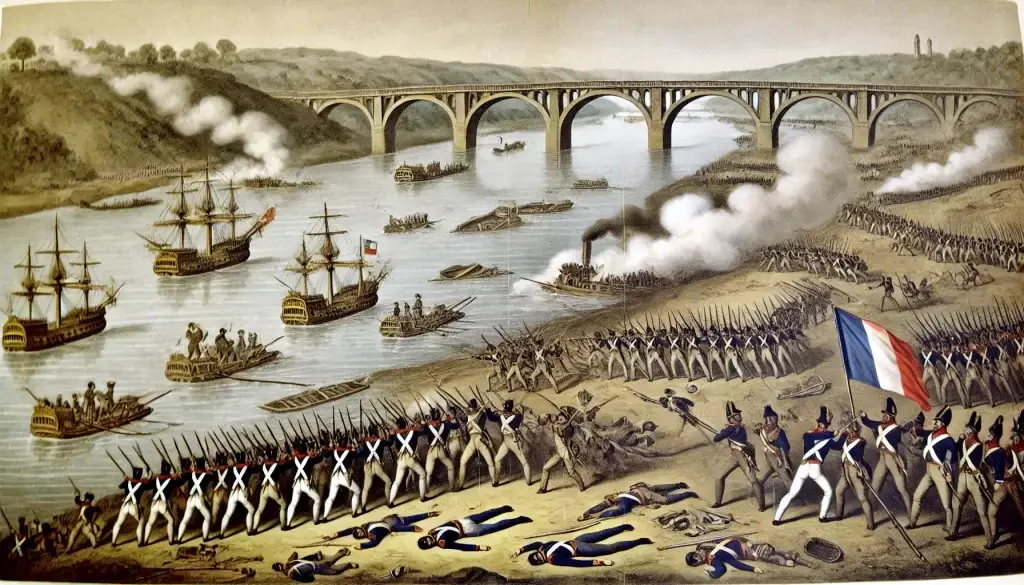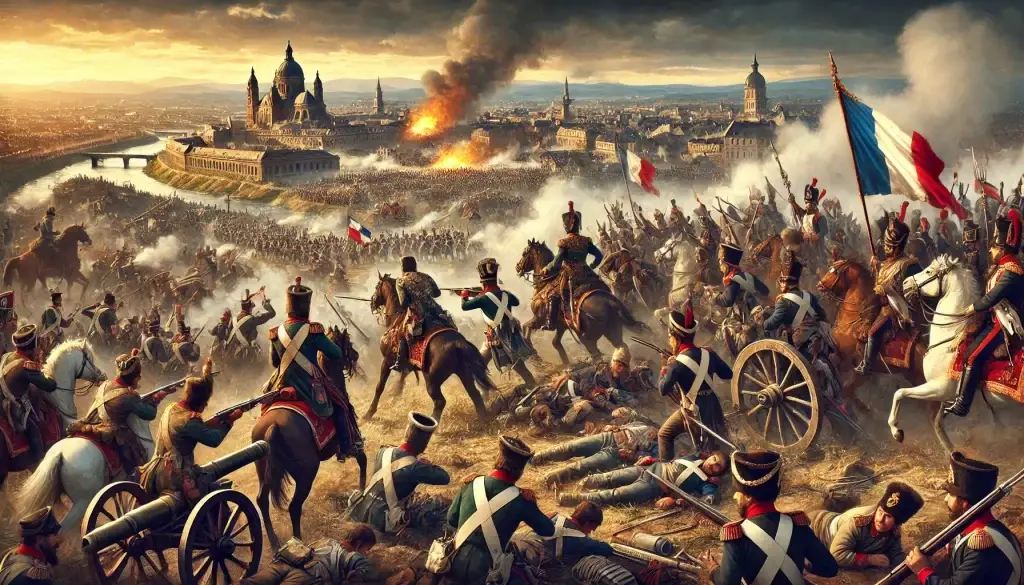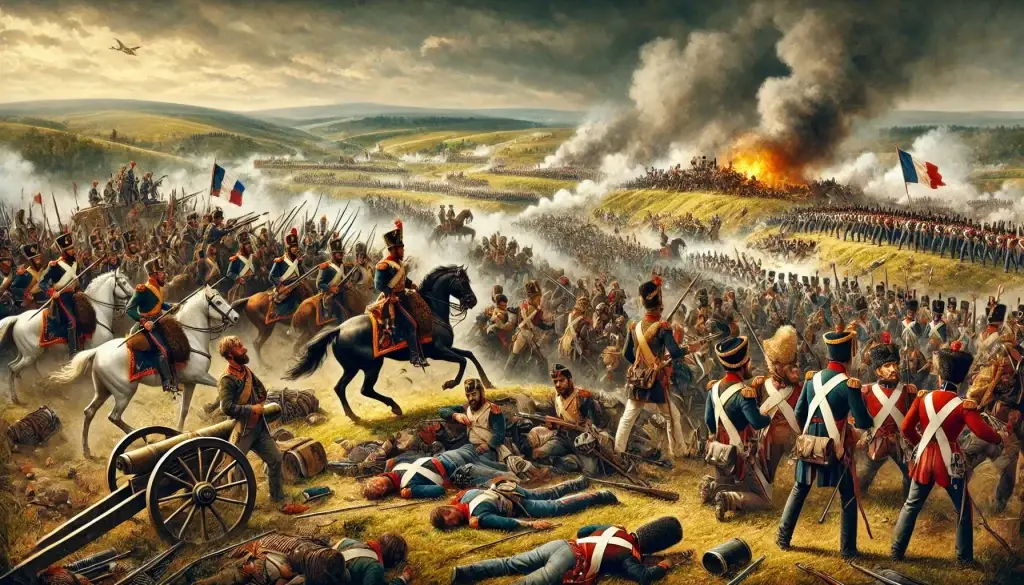When we think of Napoleon Bonaparte, we often recall a formidable leader whose military genius shaped the course of history. Yet, even the most celebrated tactician has faced moments of defeat.
Napoleon Bonaparte rose to prominence during the French Revolution, becoming Emperor of France in 1804. His military prowess earned him numerous victories, but his career wasn’t without setbacks. Below, we examine six battles the French army lost under Napoleon Bonaparte.
Battle of Acre
The Siege of Acre, which took place from March 20 to May 21 1799, was a key conflict during Napoleon’s campaign in the Middle East. Acre was a strategic fortress town in modern-day Israel situated on the eastern Mediterranean coast. Napoleon aimed to expand his influence into the Ottoman Empire, and capturing Acre was crucial for his plans.
The siege began with Napoleon’s forces attempting to breach the fortified walls of Acre. Despite several assault attempts, the defenders, supported by the British Navy under the leadership of Sir Sidney Smith, managed to repel the attacks. The walls of Acre, bolstered by reinforcements and superior artillery, withstood the French onslaught. Napoleon’s troops suffered from supply shortages and diseases, further weakening their position. The prolonged siege strained French resources and morale, ultimately leading to their withdrawal.
Napoleon’s failure to capture Acre significantly affected his Middle Eastern ambitions. It marked a turning point, thwarting his plans to advance further into the Ottoman territory. The British gained confidence and solidified their regional presence, disrupting French operations in the region.
Battle of Aspern-Essling

The Battle of Aspern Essling occurred between May 21 and 22 in 1809 near Vienna during the War of the Fifth Coalition. The French, aiming to cross the river and outflank the Austrian army led by Archduke Charles, faced logistical challenges that ultimately contributed to their defeat. This defeat was Napoleon’s first as the head of state and first in 10 years after the battle of Acre.
Despite his previous triumphs in the Italian campaign, Napoleon found himself outmatched by the more substantial and well-prepared Austrian forces while attempting to cross the Danube River. The Austrians executed a series of well-coordinated manoeuvres that disrupted French lines and denied the French resupply and reinforcements. The Austrians were reported to have fired over 50,000 rounds compared to 25,000 rounds fired by the French. Over the course of two days, 20,000 French soldiers were killed, including Marshal Jean Lannes, one of Napoleon’s field commanders.
The Battle of Aspern-Essling marked a pivotal point in Napoleon’s campaign, being one of his rare but significant defeats. This battle illuminated the vulnerabilities within Napoleon’s military planning, particularly the challenges of coordinating large-scale river crossings under enemy fire.
However, despite their victory, the Austrians did not take advantage and allowed the French to regroup and reinforce. One month later, the French, at another attempt to cross the Danube River, defeated the Austrians at the Battle of Wagram.
Battle of Krasnoie
The Battle of Krasnoie took place between 15 and 18 November 1812 during the French invasion of Russia. This encounter was a part of Napoleon’s gruelling retreat from Moscow, as his Grande Armée struggled against the harsh Russian winter and relentless Russian forces under General Mikhail Kutuzov.
Napoleon’s army, weakened by starvation, cold, and exhaustion, was attempting to regroup and escape Russia. At Krasnoie, Russian forces launched a series of raids and assaults to isolate and destroy the fragmented French divisions. Despite his dwindling resources, Napoleon’s strategic ingenuity and the valiant efforts of his units, particularly the Imperial Guard, enabled parts of his army to break through the encirclement. However, continuous Russian attacks resulted in significant losses for the French.
The Battle of Krasnoie was devastating for Napoleon. Though he managed a tactical escape, the engagement inflicted heavy casualties and further demoralized his already crippled army. Although the French army was able to avoid total annihilation through brilliant tactical manoeuvres by the French Imperial Guard, the battle confirmed the failure of Napoleon’s campaigns in Russia.
Battle of Leipzig

The Battle of Leipzig, also known as the Battle of Nations, took place from 16 to October 19 1813. It was one of the largest and most decisive confrontations of the Napoleonic Wars, involving the combined forces of Austria, Prussia, Russia, and Sweden against Napoleon’s army. The clash unfolded in Leipzig, Saxony, with Napoleon striving to defend his dominance in Europe against the growing coalition.
The battle commenced with the coalition armies launching simultaneous assaults on the French positions. Despite being outnumbered, Napoleon employed his tactical ingenuity to mount a robust defence. However, coalition forces’ overwhelming numerical superiority and coordinated strikes steadily eroded the French resistance.
Over four days of intense fighting, Napoleon’s troops suffered relentless attacks, with heavy artillery bombardments and close-quarter combats severely depleting their ranks. The strategic use of cavalry by the coalition further compounded Napoleon’s challenges, ultimately leading to his forces being encircled and outflanked.
Napoleon’s defeat at Leipzig signified a monumental blow to his imperial ambitions. Forced to retreat to France, his control over the conquered territories began to crumble. The coalition forces’ victory at Leipzig invigorated the allied nations and marked a major shift in the balance of power in Europe. The reverberations of Leipzig hastened the eventual downfall of Napoleon’s reign, leading to his first abdication and exile to Elba.
Battle of Leon
On March 9 – 10, 1814, during the War of the Sixth Coalition, Napoleon faced the Allied forces. This battle was part of the larger campaign to defend France from invasion. Following the costly Battle of Craonne on March 7, Napoleon pursued Gebhard Leberecht von Blücher.’s retreating forces towards Laon, a strategically vital town due to its elevated position and fortifications. Despite being weakened, Napoleon aimed to decisively defeat the Prussians to regain the upper hand in the campaign.
It was a significant conflict between Napoleon’s French army and the Prussian forces under Field Marshal Gebhard Leberecht von Blücher. This battle took place during the War of the Sixth Coalition, which aimed to end Napoleon’s dominance in Europe.
Blücher, bolstered by Russian reinforcements under Ferdinand von Wintzingerode and a Prussian corps led by Friedrich Wilhelm Freiherr von Bülow, managed to repel the French assaults. The Prussian forces, well-entrenched and supported by artillery, inflicted heavy casualties on the French. Street fighting erupted in the suburbs of Laon, but the French were unable to break through the Prussian defences.
Napoleon, outnumbered and facing coalition forces on multiple fronts, employed his usual aggressive tactics. However, the Allies had learned from past encounters and adapted their strategies accordingly. Despite their tenacity, the French forces could not secure a decisive victory.
The Battle of Loan highlighted the diminishing returns of Napoleon’s aggressive tactics against a well-coordinated enemy. It became clear that the coalition forces had learned to counter his strategies effectively and that the French empire under Napoleon was now fighting for its survival.
Battle of Waterloo

The Battle of Waterloo, fought on June 18 1815, marked the final stand of Napoleon Bonaparte following his return from exile in Elba. The battle took place near Waterloo, in present-day Belgium, where Napoleon’s forces faced off against the Duke of Wellington’s Anglo-allied army, supported by Prussian troops under Blücher. Napoleon sought to reclaim his former glory and re-establish his dominance over Europe through this decisive engagement.
The confrontation at Waterloo began with a meticulously planned assault by Napoleon, who aimed to divide and conquer the Allied forces before they could fully unite. He moved his units to engage the allied forces in Belgium; however, the Duke of Wellington anticipated the move and mounted a fierce resistance to thwart Napoleon’s advances.
As the day progressed, the arrival of Blücher’s Prussian forces on the battlefield turned the tide against Napoleon. Intense fighting ensued, with the French Imperial Guard making a final attempt to break the Allied lines. However, the combined strength and coordination of Wellington’s and Blücher’s forces overwhelmed Napoleon’s exhausted army.
The defeat at Waterloo culminated in Napoleon’s final abdication and marked the end of the Napoleonic Wars. Captured and exiled to the remote island of Saint Helena, Napoleon’s downfall from the heights of power was complete. For Europe, the Battle of Waterloo signalled the restoration of monarchical order and reshaping the continental political landscape.
Conclusion
Analyzing these battles provides a comprehensive view of Napoleon’s military career, revealing his brilliance and limitations. Each defeat offers valuable lessons in strategy, logistics, and adaptability.
Which of these defeats do you think is most significant in the eventual fall of Napoleon Bonaparte?
Share your opinions in the comments.
